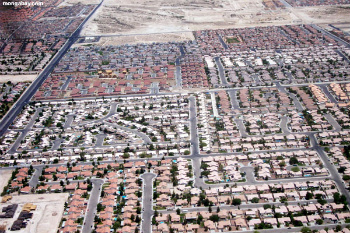The Sustainable Sites Initiative has developed the United States’ first rating system for the design, construction, and on-going maintenance of a wide-variety of landscapes, both with and without buildings, including shopping malls, subdivisions, university campuses, corporate buildings, transportation centers, parks and other recreation areas, and single-family homes.
“While carbon-neutral performance remains the holy grail for green buildings, sustainable landscapes move beyond a do-no-harm approach,” said Nancy Somerville, Executive Vice President and CEO of American Society of Landscape Architects (ASLA). “Landscapes sequester carbon, clean the air and water, increase energy efficiency, restore habitats and ultimately give back through significant economic, social and environmental benefits never fully measured until now.”
 Las Vegas sprawl. Photo by: Rhett A. Butler. |
The ratings system analyzes sites’ energy and water usage, waste management, impact on land, and use of natural resources both during construction and maintenance.
“We are facing unprecedented environmental challenges such as water scarcity and climate change that require fundamental changes in the way that we interact with the land,” said Susan Rieff, Executive Director of the Lady Bird Johnson Wildflower Center at The University of Texas at Austin. “This voluntary rating system and guidelines covers all aspects of working with outdoor spaces of all sizes, and provides information for designing landscapes that go beyond beauty to actually improving ecosystem health and the health of communities for generations to come.”
Dozens of experts across the US spent four years developing the Sustainable Sites Initiative’s rating system, which has been a partnership with ASLA, the Lady Bird Johnson Wildflower Center, and the US Botanic Garden. Built on a 250-point scale, the ratings system grants between one to four stars based on whether the site has achieved 40, 50, 60, or 80 percent on the scale respectively.
“Landscapes can give back,” said Holly H. Shimizu, Executive Director of the United States Botanic Garden. “We believe that as these guidelines become widely used, not only will they be as transformative to the landscape industry as LEED was to buildings, but more than that, they will allow built landscapes to be regenerative like natural landscapes, and assist in mitigating some of the most pressing environmental issues we face today. We need to acknowledge our landscapes’ value, treasure them and cultivate them sustainably and responsibly. The need is urgent, the time is now and these guidelines, when used correctly, are the tools.”
In order to test the system, the Sustainable Sites Initiative has called for pilot projects on any type of designed landscape of at least 2,000 square feet.
Reports issued by the Sustainable Sites Initiative, entitled The Case for Sustainable Landscapes and Guidelines and Performance Benchmarks 2009, are available for download at www.sustainablesites.org.
Related articles
Declaration calls for more wilderness protected areas to combat global warming

(11/11/2009) Meeting this week in Merida, Mexico, the 9th World Wilderness Congress (WILD9) has released a declaration that calls for increasing wilderness protections in an effort to mitigate climate change. The declaration, which is signed by a number of influential organizations, argues that wilderness areas—both terrestrial and marine—act as carbon sinks, while preserving biodiversity and vital ecosystem services.
Private U.S. landowners may qualify for carbon payments under proposed legislation
(10/07/2009) Have you ever found yourself wondering what your backyard is worth in carbon? It may seem like a silly question – especially when deforestation in rainforest nations with millions of acres of tropical forest are spewing more CO2 into the atmosphere than any single industry – but small-scale deforestation in the developed world adds up. Now, eight US Senators, who have sponsored a bipartisan bill in the United States to supplement the American Clean Energy and Security Act, aim to prove that small-scale forest projects are nothing to sneeze at.
Clean energy investment moving too slowly to avoid irreversible climate change
(03/04/2009) Stalled clean energy investment due to the current recession makes severe climate change more likely, according to a new report by analysts with New Energy Finance (NEF).







